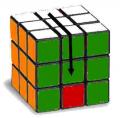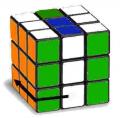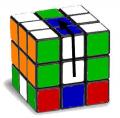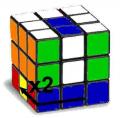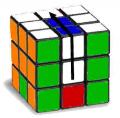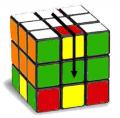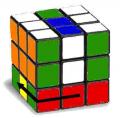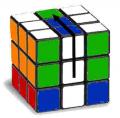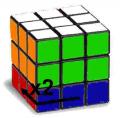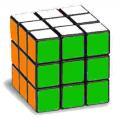Terminology
When describing the solution for the 2nd and 3rd layers, standard
cube notation will be used. Here's what you need to know to read it:
| F = front face |
B = back face |
R = right face |
L = left face |
U = up face |
D = down face |
In addition to a letter, each move may be accompanied by an apostrophe or the number two:
- A letter by itself means turn that face 90 degrees clockwise (eg. F).
- A letter followed by an apostrophe means turn that face 90 degrees anti-clockwise (eg.
F').
- A letter followed by the number 2 means turn that face 180 degrees (direction is irrelevant), (eg.
F2).
So
R U' L2 is shorthand for
"turn the right face 90 degrees clockwise, then turn the up face 90 degrees anti-clockwise, then turn the left face 180 degrees".
When thinking whether to turn clockwise/anti-clockwise, imagine that
you are looking directly at the particular face you are turning.
For each algorithm, the notation is written with the assumption
that the core of the cube remains fixed throughout the whole algorithm,
and the faces just turn around it. This means that you also need to know
how to position the cube to start the algorithm.
The Solution
 The First Layer
The First Layer
The first layer is solved in two stages:
- Form the cross
- Insert the 4 first layer corners (each corner is inserted individually)
I believe that the first layer should be done intuitively. You need
to understand it and solve it without learning algorithms. Until you can
do this, I wouldn't bother attempting the rest of the cube! So, spend
some time playing with the cube and familiarising yourself with how to
move the pieces around the cube.
Now, here are some tips to get you started.
 The Cross
The Cross
I prefer to start with the white cross because I find white easier to
quickly identify on a completely scrambled cube, however, you can use
any colour.
There are 4 edge pieces with white (ie. the 4 arms of the cross)
which have specific positions. You can't put any white edge piece in an
arm of the cross because the other colour on the edge cubie must match
up with it's centre on the middle layer.
 Here is a pic of what a correctly formed cross looks like (grey denotes cubies that are irrelevant to the cross). Note that the white/red edge cubie matches up with the white centre and the red centre. Ditto re the white/blue cubie.
Here is a pic of what a correctly formed cross looks like (grey denotes cubies that are irrelevant to the cross). Note that the white/red edge cubie matches up with the white centre and the red centre. Ditto re the white/blue cubie. |
 Here's a pic on an incorrectly formed cross. Looking at the white face we do indeed see a white cross, however the white/red edge cubie does not match up with the red centre. Ditto re the white/blue cubie. This is bad! Here's a pic on an incorrectly formed cross. Looking at the white face we do indeed see a white cross, however the white/red edge cubie does not match up with the red centre. Ditto re the white/blue cubie. This is bad! |
For a detailed explanation of the cross, check out Dan Harris'
Solving the Cross page.
 The First Layer Corners
The First Layer Corners
Once you have completed the cross, completing the first layer
requires inserting each of the 4 corners in separately. The first thing
to do is examine your cube and locate all of the top layer edge pieces -
they will be sitting in either the
first layer or the last layer. Inserting the first layer corners should
be done intuitively, not by learning algorithms. To get you started,
here's a step-by-step example of one way to insert a
first layer corner.
 Step 1 Step 1
The blue/red/white corner is sitting in the bottom layer (the blue part is facing the bottom so we can't see it in this picture). Turn the blue face 90 degrees anti-clockwise.
|
 Step 2 Step 2
Now your cube should look like this. Move the D face 90 degrees anti-clockwise to line up the blue/white edge with the blue/white/red corner.
|
 Step 3 Step 3
Now that the blue/white edge and the blue/white/red corner have been lined up, re-form the white cross by turning the blue face 90 degrees clockwise.
|
 Step 4 Step 4
Now the blue/white/red corner is in its correct place.
|
Here are some tips for inserting the top layer corners:
- Start with a first layer corner that is sitting in the last layer.
- If there are multiple first layer corners in the last layer
(there usually will be), start with one that does not have the white
part of the corner on the face
opposite the white face. Or, if you were using a different colour for
the cross ('colour X'), start with a corner that does not have the
'colour X' part of the corner on the face
opposite the 'colour X' face.
- When working with a first layer corner piece that is in the first
layer (but in the wrong
first layer corner position), you will need to get it out of the first
layer into the
last layer, then insert it into the correct first layer corner position.
The same principle applies if a
first layer corner piece is in the correct first layer corner position
but needs to be flipped around. You need to get it out of the
first layer (ie. into the last layer), and then re-insert it into the
first layer the correct way around.
 |
This is what the first layer should look like when finished.
|
 The Middle Layer
The Middle Layer
The middle layer consists of one stage:
- Insert the 4 middle layer edges (each edge is inserted individually).
You only need to learn one algorithm (plus the mirror algorithm) for
the second layer. There are many more algs, but let's just learn the
essential one first.
First, locate a middle layer edge that is currently sitting in the last layer. I'm going to use the
blue/
red edge for this example.
 |
This blue edge cubie in the last layer is the blue/red edge cubie.
|
In this picture,
U=white, L=red and F=blue.
We can't see the other three faces, but obviously the R face is the one
opposite the L face, the D face is opposite the U face and the B face
is opposite the F face.
Now, position the
blue/
red edge piece so that the colour on the side of the cube (
blue in this case) lines up with it's centre. Now perform the following algorithm:
D L D' L' D' F' D F
If the
blue/
red edge piece was flipped the other way so that the
blue was on the bottom rather than the
red, you would position the cubie under the
red centre and perform the following alg:
D' F' D F D L D' L'.
This is the mirror of the previous algorithm. The axis of symmetry lies
diagonally across the white face, and along the line which divides the
blue face and the
red face.
What if the edge piece is not in the last layer?
The instructions above assume that the middle layer edge piece you are inserting is sitting somewhere in the last layer.
If some middle edges are in the last layer and some are in the middle
layer in the wrong spot, always start working with the edge pieces that
are in the last layer. After you've done this, sometimes (but not too
often) you'll be left with a middle layer edge piece that's in the
middle layer but in the wrong spot. In this situation, you can use the
same middle layer algorithms from above (D L D' L' D' F' D F or D' F' D F D L D' L')
to insert another edge piece into the middle layer edge position,
thereby knocking the middle layer edge piece out of its spot and into
the last layer. Once you've done this, the middle layer edge piece is in
the last layer and you can deal with it in the usual way.
There is a short-cut to this problem, but as this is a beginner solution with
minimal memorisation, I haven't included it here. If you really want to learn
it, take a look at
Case Dd2 on Dan Harris' site. |
|
The red/blue
middle layer edge piece is in the middle layer but not oriented
correctly. It needs to be moved to the last layer, then put back into
the middle layer in the right way.
|
 The Last Layer
The Last Layer
The last layer ("LL") is done in 4 steps:
- Orient the edges (2 algs) - i.e. form a cross on the D face.
- Permute the corners (1 alg) - i.e. get the corners in the correct
position in 3D space (don't worry if they still need to be rotated).
- Orient the corners (1 alg + mirror alg) - i.e. flip the corners.
- Permute the edges (1 alg) - i.e. swap the edges around. The cube should now be solved! :)
All last layer algorithms are performed with the cross (i.e. the first layer -
white side in this example) on the bottom.
 Orienting the LL Edges
Orienting the LL Edges
Once you have completed the first two layers ("F2L"), hold the cube
so that the white side is on the bottom. The white side will be on the
bottom for the remainder of the solution. This means that the white side
is the D side for all last layer algorithms.
On my cube, white is opposite yellow, therefore yellow is the U face
for all last layer algorithms on my cube. Note that your cube may have a
different colour opposite white (e.g. blue). Now have a look at your
last layer, and in particular, look at the last layer face - there are 4
possible patterns of LL edges that you may see.
 State 1 State 1
|
 State 2 State 2
|
 State 3 State 3
|
 State 4 State 4
|
Unlike with the initial cross (where all the edges must match up
with the white centre and with the centres on the middle layer), here
all you need to worry about is getting all the last layer edges matching
up with the last layer centre. It doesn't matter if the other colour on
the LL edge piece does not match up with the colour on the middle layer
centre. Also, ignore the LL corners too. It doesn't matter what they
are doing at the moment. Now, let's consider each of these LL edge
states separately.
 |
State 1
All the edges are already oriented correctly. Move on to permuting the corners.
|
 |
State 2
We are going to re-orient our faces for this
algorithm. The face you are looking directly at in this picture is now
the U face (it was the D face for when you were doing the second layer
edges). Perform the following algorithm: F U R U' R' F'
|
 |
State 3
As with State 2, the face you are looking directly at in this picture is now the U face. Perform the following algorithm: F R U R' U' F'
|
 |
State 4
State 4 is really a combination of States 2 and
3, so all you need to do is perform the algorithm for either State 2 or
State 3. Once you've done this, you'll see that your LL edges now look
like State 2 or State 3, so just perform the appropriate algorithm and
you will have a cross on the LL.
|
 Permuting the LL Corners
Permuting the LL Corners
The two possible states are:
- two adjacent LL corners need to be swapped; or
- two diagonal LL corners need to be swapped.
These are the only two possible states. If you cannot identify one of these two states with your LL corners then one
or more of the following must be true:
- You have not finished the F2L.
- Someone has ripped out a corner of your cube and put it in the wrong way.
- Someone has ripped off some of your stickers and put them back in the
wrong place.
- You are not looking hard enough. ;)
Swapping adjacent corners
Hold the cube with the white side on the bottom, and the two
corners to be swapped are in the front right top and the back right top
positions. Perform the following algorithm:
L U' R' U L' U' R U2.
To see an animated version of this algorithm, see the first algorithm on
Lars Petrus'
Step 5 page. On Lars' site, the algorithm is being executed from a slightly
different angle (the two corners being swapped are front-top-right and
front-top-left), but it is the same exact algorithm.
Swapping diagonal corners
Swapping diagonal corners can be done by executing the adjacent
corner swap algorithm twice. Perform it once to swap any two LL corners.
Re-examine you cube and you'll see that now there are just two LL
corners that need to be swapped. Position it correctly for the final LL
adjacent corner swap and perform the LL adjacent corner swap algorithm.
 Orienting the LL Corners
Orienting the LL Corners
There are 8 possible orientation states for the LL corners. One is
where all 4 corners are correctly oriented. The other 7 look like this.
 State 1 State 1
|
 State 2 State 2
|
 State 3 State 3
|
 State 4 State 4
|
 State 5 State 5
|
 State 6 State 6
|
 State 7 State 7
|
 |
State 1. Twisting three corners anti-clockwise
R' U' R U' R' U2 R U2 |
 |
State 2. Twisting three corners clockwise
R U R' U R U2 R' U2
To see an animated version of this algorithm, look at
Lars Petrus' Sune algorithm. |
States 3-7
Once you know the algorithms for States 1 and 2, you can solve any LL
orientation State. The remaining States can be oriented using a maximum
of 2 algorithms. You will need to do one of the following (i) the State 1
algorithm twice, (ii) the State 2 algorithm twice, (iii) the State 1
algorithm, then the State 2 algorithm, or (iv) the State 2 algorithm,
then the State 1 algorithm.
In a previous edition of this solution, I had said that I'm not
going to tell you
exactly how to combine the State 1 and State 2 algorithms to solve
States 3-7.
My reason for this was because it is important that you try to
understand how the State 1 and the State 2 algorithms work,
and that once you do understand them you will be able to work out how to
use them to solve all the States.
I still believe this, however, I received emails from a few people who
were having trouble with States 3-7, so I decided to write some extra
tips. I still suggest that you try to work out States 3-7 by yourself,
but if you are really stuck, have a look here:
Orienting the Last Layer Corners: further tips.
 Permuting the LL Edges
Permuting the LL Edges
There are 5 possible permutation states for the LL edges. One is
where all 4 edges are correctly permuted. The other 4 look like this.
 State 1 State 1
R2 U F B' R2 F' B U R2
|
 State 2
State 2
R2 U' F B' R2 F' B U' R2
This is almost identical to the algorithm for State 1. Only difference is the 2nd move and the 2nd last move.
For an animated version of this algorithm, see the
Lars Petrus' Allen algorithm. The
algorithm is being executed from a slightly different angle, but it is the same
exact algorithm. |
 State 3 State 3
Apply the algorithm for either State 1 or State 2. Re-examine your cube and it will now look like State 1 or State 2.
|
 State 4 State 4
Apply the algorithm for either State 1 or State 2. Re-examine your cube and it will now look like State 1 or State 2.
|
And that's all you really need to know to solve the Rubik's Cube!
 Here is a pic of what a correctly formed cross looks like (grey denotes cubies that are irrelevant to the cross). Note that the white/red edge cubie matches up with the white centre and the red centre. Ditto re the white/blue cubie.
Here is a pic of what a correctly formed cross looks like (grey denotes cubies that are irrelevant to the cross). Note that the white/red edge cubie matches up with the white centre and the red centre. Ditto re the white/blue cubie. Here's a pic on an incorrectly formed cross. Looking at the white face we do indeed see a white cross, however the white/red edge cubie does not match up with the red centre. Ditto re the white/blue cubie. This is bad!
Here's a pic on an incorrectly formed cross. Looking at the white face we do indeed see a white cross, however the white/red edge cubie does not match up with the red centre. Ditto re the white/blue cubie. This is bad! Step 1
Step 1
 Step 2
Step 2
 Step 3
Step 3
 Step 4
Step 4



 State 1
State 1
 State 2
State 2
 State 3
State 3
 State 4
State 4




 State 1
State 1
 State 2
State 2
 State 3
State 3
 State 4
State 4
 State 5
State 5
 State 6
State 6
 State 7
State 7


 State 1
State 1
 State 2
State 2 State 3
State 3 State 4
State 4



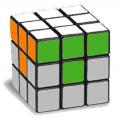
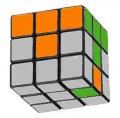
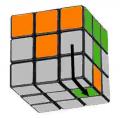
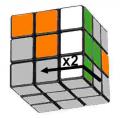
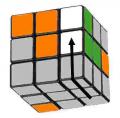
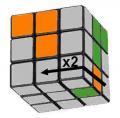
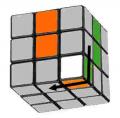

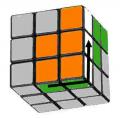
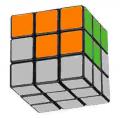
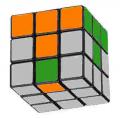
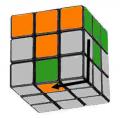
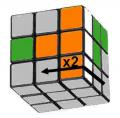
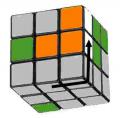
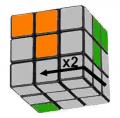
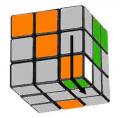
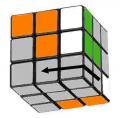
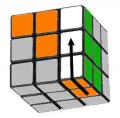

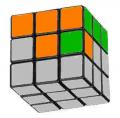
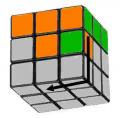
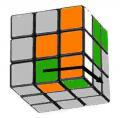
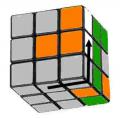
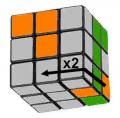
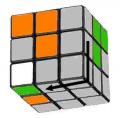

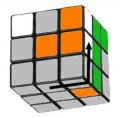
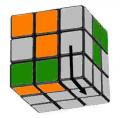
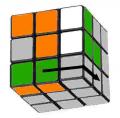
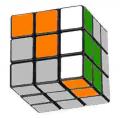
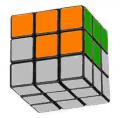

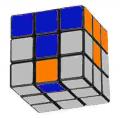
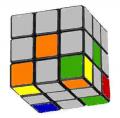
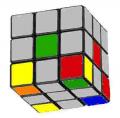
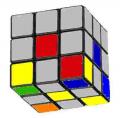
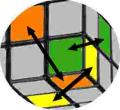


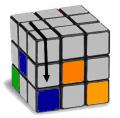
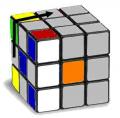
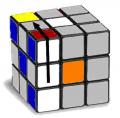
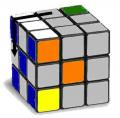
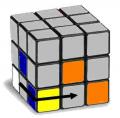
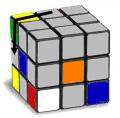
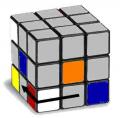
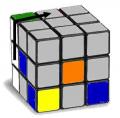
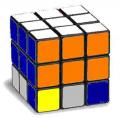
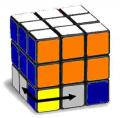
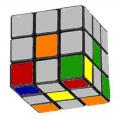
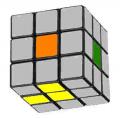
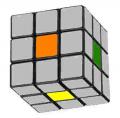
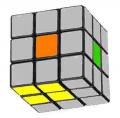
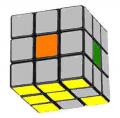
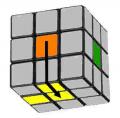
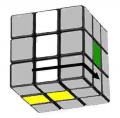
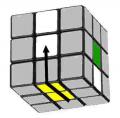
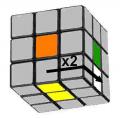
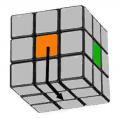

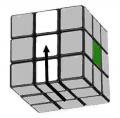
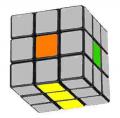
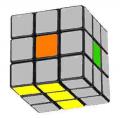
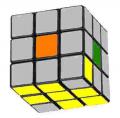

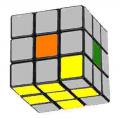
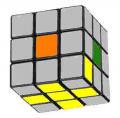

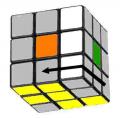
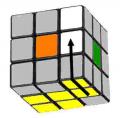

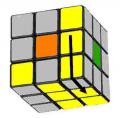
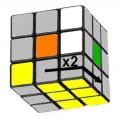
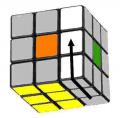
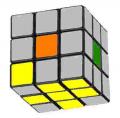
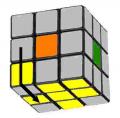
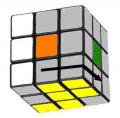
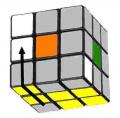
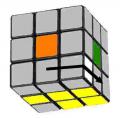

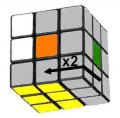
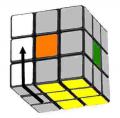
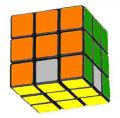
 et donc vous n'avez pas besoin de faire l'étape 6, logique ^^.
et donc vous n'avez pas besoin de faire l'étape 6, logique ^^.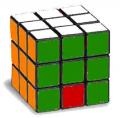

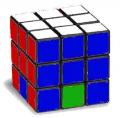 Dans
ce cas on s'intéresse aux faces verte et bleue qui bordent la face
orange complétée. On remarque qu'il y a du vert sur les deux faces, on
va donc effectuer la formule sur la face ayant le plus de vert (face de
centre vert).
Dans
ce cas on s'intéresse aux faces verte et bleue qui bordent la face
orange complétée. On remarque qu'il y a du vert sur les deux faces, on
va donc effectuer la formule sur la face ayant le plus de vert (face de
centre vert).